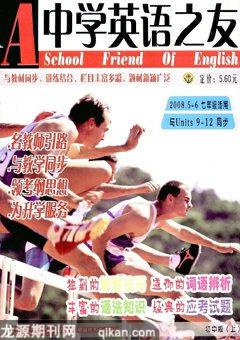初一易错点归类分析
李国勤
一、名词类:
1. 这些男老师们在干什么?
[误] What are the man teachers doing?
[正] What are the men teachers doing?
[析] 在英语中,当一名词作定语修饰另一名词(单或复数形式)时,作定语的名词一般要用其单数形式;但当man, woman作定语修饰可数名词复数形式时,要用其复数形式men, women。
2. 我想为我儿子买两瓶牛奶。
[误] I want to buy two bottle of milk for my son.
[正] I want to buy two bottles of milk for my son.
[析] 表示不可数名词的数量时,常用“a/an或数词+表量的可数名词+of+不可数名词”这一结构, 其中当数词大于1时,表量的可数名词要用其复数形式。
3. 这是那对双胞胎的房间。
[误] This is the twinss room.
[正] This is the twins room.
[析] 以字母s结尾的普通名词的所有格只在其后直接加“ ‘ ”构成即可。
4. 在小轿车里的那位女士是彼得和汤姆的妈妈。
[误] The lady in the car is Peters and Toms mother.
[正] The lady in the car is Peter and Toms mother.
[析] 表示几人共同拥有某人或某物时, 只在最后一个人名后加“‘s”; 若是几人分别拥有某人或某物时, 则在每个人名后分别加“‘s”。
二、动词类:
5. 你妹妹通常什么时候去上学?
[误] What time does your sister usually goes to school?
[正] What time does your sister usually go to school?
[析] 借助助动词do(或does)构成疑问句或否定句时, 句中的谓语动词用其原形。
6. 琳达晚上经常做作业, 但今晚她在看电视。
[误] Linda often do her homework in the evening, but this evening she watching TV.
[正] Linda often does her homework in the evening, but this evening she is watching TV.
[析] 在初一英语学习阶段,我们接触到了两种主要时态: 一般现在时和现在进行时。一般现在时表示经常性的或习惯性的动作,常和often, usually, sometimes 等时间状语连用。在一般现在时的句子中, 若主语是第三人称单数, 谓语动词要用其第三人称单数形式。现在进行时表示现阶段正在进行或发生的动作,现在进行时由be(am/is/are)+v-ing形式构成。
7. 这双鞋是红色的。
[误] This pair of shoes are red.
[正] This pair of shoes is red.
[析] 在shoes, trousers, gloves, glasses等表示成双成对的衣物或工具名词前用pair(表计量)修饰时, 谓语动词的形式由pair的单复数形式来决定。
三、代词类:
8. 这张票是她的,不是我的。
[误] This is hers ticket. Its not my.
[正] This is her ticket. Its not mine.
[析] 物主代词有形容词性物主代词和名词性物主代词之分:形容词性物主代词之后一定要接名词, 而名词性物主代词之后不需接任何词。
9. 吴老师教我们英语。
[误] Miss Wu teaches our English.
[正] Miss Wu teaches us English.
[析] teach sb. sth.中的sb.作teach的宾语, 因此当sb.为人称代词时要用其宾格形式。
四、介词类
10. 你能找到这个问题的答案吗?
[误] Can you find the answer of this question?
[正] Can you find the answer to this question?
[析] 英语中用“the answer to…”表示“……的答案”。
类似结构还有the key to the door, the way tothe zoo等。
11. 那个穿着红裙子的小女孩是我们老师的女儿。
[误] That little girl on a red skirt is our teachersdaughter.
[正] That little girl in a red skirt is our teachersdaughter.
[析] 用介词表示“穿戴衣物”时, 只能用in,其他介词没有此用法。
五、副词类:
12. 莉莉,你为什么不回家呢?
[误] Lily, why dont you go to home?
[正] Lily, why dont you go home?
[析] come, go 等后接here, there, home等地点副词时,地点副词前不加to。
六、连词类:
13. 我喜欢语文和英语, 但我不喜欢体育和历史。
[误] I like Chinese and English, but I dont like P.E. and history.
[正] I like Chinese and English, but I dont like P.E. or history.
[析] 在肯定句中, 并列成分之间用and来连接;而在否定句中, 并列成分之间的连接需要用or。
七、冠词类:
14. 乘飞机去北京花了史密斯一家人一个小时。
[误] It takes Smiths a hour to go to Beijing by a plane.
[正] It takes the Smiths an hour to go to Beijing byplane.
[析]
1.表示“……一家人”用结构“the+姓氏复数”;
2.hour 一词的第一个字母不发音, 它是以元音音素开头的, 所以“一小时”要用an hour;
3.用介词by表示“乘坐”某种交通工具时, 交通工具名词前不加任何冠词。
八、there be 句型类:
15. “房间里有什么?” “有一些桌子和椅子。”
[误]——What are in the room?
——There are some desks and chairs.
[正]——What is in the room?
——There are some desks and chairs.
[析]就There be句型中的主语进行提问时, 无论主语是单数形式还是复数形式, 均要用“What/Who is+介词短语?”, 即其中的谓语动词均用单数形式is。
九、句法类:
16. “你不是学生吗?” “不,我是学生。”
[误] ——Aren't you a student?——No, I am.
[正] ——Aren't you a student?——Yes, I am.
[析] 对否定疑问句的回答是用Yes还是用No,这取决于实际情况: 如果事实是肯定的,就用Yes表“不”; 如果事实是否定的, 就用No表“是的”。

